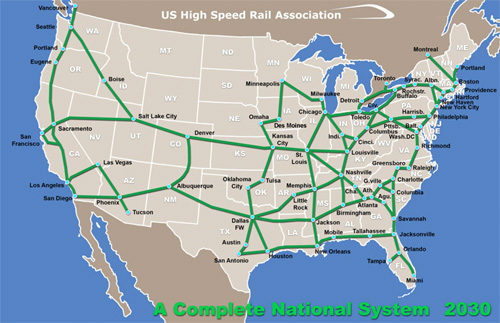A map of the proposed high speed rail network shows more than a dozen connections between the country’s major population centers. It’s easy and exciting to imagine rocketing from Fort Worth to Austin, Texas at more than 100 miles per hour. But it’s equally difficult to understand whether a rail project is a flight of fancy, stalled with funding woes, or under way with plans for passengers.
Consultants with an interest in high speed rail projects need to know in which phase a project is progressing. And which phases and types of work are coming next.
With high speed rail projects, surveyors and geotechnical engineers are needed soon after a feasibility study. An architect may be needed for the design of a new transit station; but not until Phase III. And there may be a critical role for developers.
Image courtesy of US High Speed Rail Association
A dozen years ago, the California High Speed Rail Authority awarded its first million-dollar project to prepare an Implementation Plan. Many RFQs and RFPs have since been issued, and the Authority has used a range of contracting methods to assemble its consultant teams for various phases. The Authority established multiple “construction packages” and selected firms to provide design build services for those segments. It also sought project/construction management firms to supplement those construction packages. And it has used a variety of environmental and engineering consultants for specific analyses.
The Authority’s most recent procurement notice is the latest phase, and provides insight into the long-term development, management, and financing of a system that would connect the San Francisco Bay Area to the Los Angeles Basin, and eventually extend to Sacramento and San Diego.
This latest Request for Expressions of Interest sought information from firms with the capability to provide design-build-finance-maintain services.
“The Authority is interested in learning how the private sector, through an integrated delivery contract, can accelerate the project delivery schedule to meet or exceed the Authority’s deadlines,” the California High Speed Rail Authority said in the REI. “Industry experience has shown that innovative delivery models, such as a design-build-finance-maintain (DBFM), can help the Authority achieve its objectives of minimizing the whole-life cost of the System, securing private sector investment, accelerating System completion, and transferring key delivery and long-term maintenance risk to the private sector.”
Developers, consortia, and government agencies are promoting high speed rail projects across the country. With tens of billions of dollars in project costs, there will be demands for architectural and engineering services at every phase.
The government-backed China Railway International consortium has announced plans to spend $100 million for initial project costs to connect the Los Angeles area with Las Vegas. XpressWest would be a 230-mile high speed rail project along the Interstate 15 corridor. With a connection in Palmdale, the XpressWest project would link up to the California High Speed Rail.
On the East Coast, All Aboard Florida has plans to improve upon existing railroad infrastructure for its $1.5 billion Miami-to-Orlando project.
In the Midwest, Chicago is poised to serve as a hub for high speed rail projects that would branch out to Detroit, Kansas City, Minneapolis, Louisville, and Cleveland.
All Aboard Erie recently requested funding to conduct a feasibility study for a high speed train. That line would link Erie to Pittsburgh, with possible connections to cities such as Buffalo.
In the Lone Star State, the Texas Central Railway, recently announced that it received $75 million in funding to move from feasibility studies to development planning for a high speed rail line between Dallas/Fort Worth and Houston.
High speed rail projects are unique in their potential to transform a region, although it is not simply reducing travel times: new multimodal transit stations, real estate and housing developments, downtown revitalization planning. There are opportunities and impacts on the macro and micro levels, and IMS is leading the way to support the architectural-engineering-consulting industry.
IMS is talking with municipal officials, tracking city council agendas, and monitoring local newspapers and agency websites to publish information on yesterday’s contract winners, today’s RFPs, and tomorrow’s Advance Notices of upcoming projects.
If you found this Industry Insight article to be of value, we invite you to sign up for a free trial through IMS to learn more about railway and other public bid opportunities on a daily basis. We’d love to hear your ideas for potential articles as well! Please contact us at: ims@imsinfo.com.



